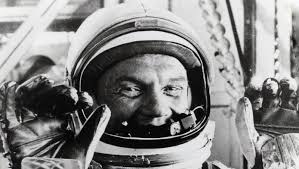
And now he belongs to the ages. John Glenn, first American to reach orbit, passed away today at 95 years old. In the years since he slipped the surly bonds of Earth in 1962, we’ve witnessed a multitude of space-related tragedies: Apollo 1’s capsule fire on the pad, Shuttle Challenger on its way to the heavens, Shuttle Colombia on its way back (and, presumably, its way up again), tragic Soviet mishaps upon reentry. We’re fragile creatures, not suited to existence outside of a narrow atmospheric pressure range and prone to death by hypo- or hyperthermia inside an alarmingly small temperature window. What makes us seal ourselves inside bathyscaphes and descend to crushing ocean depths? Or buckle into tin cans atop volatile rockets, with the end goal being a helpless meat assemblage entirely dependent upon its pressurized, heat-regulated space suit to remain safe while floating in the cruel void? Madness. But yet we crave these opportunities. We make heroes of those who act on such obsessions. We live vicariously through them. Governments have funded mega-billion-dollar proxy wars based purely on touching an orbiting rock and coming home in one piece.
For over a half century, we’ve been at this game—and it’s never really become anything resembling “safe” or “routine.” Case in point: John Glenn. He was perhaps the most eminently qualified of the vaunted Mercury 7, that initial group of American test pilots who were arguably the most qualified for the job of strapping into a metal cone and being hurled into the great beyond for a few minutes or hours. Glenn and the others were tested, poked, prodded, tortured and otherwise highly inconvenienced by teams of scientists and doctors who had no idea what being ready for space actually meant. Spun, injected, probed, placed into temperature extremes, practically waterboarded (or maybe actually waterboarded) and driven past the point of exhaustion, these men displayed their mettle and prepared to become only the second type of monkey thrust out of the atmosphere. Glenn will be remembered for his amiability and charm during the lead up to his flight. He was a natural with the press, and he always knew where the camera and the microphone were. He was well spoken, but never overbearing. He might wear a bow tie to subtly set himself apart from the straight tie-wearing other six, but if there were grumblings of politicking, they were only that; the face he showed the United States public was THE face of a red, white, and blue, apple-pie astronaut. He was embodiment. Which makes his bleak demise all the more hard to take. Some said Glenn had the makings of a national politician, a mover and shaker in the halls of Congress—possibly even presidential material. But he stuck to his path. He desired to touch what lay past the highest, faintest wisps of our atmosphere. He chose space.
Mercury-Atlas 6, as the mission was officially called, weathered several delays spanning January and February 1962. Finally, on February 20, Glenn boarded his capsule, nicknamed Friendship 7, and crammed himself in among the instruments and food stores. Nearly four hours later, the Atlas missile beneath him lit its engines, delivering Glenn on a bumpy ride into orbit.
Americans were transfixed by the astronaut’s descriptions of “beautiful” twilights and “the shortest day I’ve ever run into,” followed by a 454-minute “night” and a new dawn. It was definitely a new dawn for the U.S. space program, which was finally on its way to catching up with the Soviets. (Their first cosmonaut had achieved orbit in April of the previous year, and, that August, Gherman Titov spent an entire day in space. An Earth day, not the 90-minute one he experienced in orbit.) Determined not only to close distance in the space race but to prove a human could live and thrive in the harsh environs, Glenn and Freedom 7 set up camp in orbit. Glenn and NASA ultimately triumphed. But the glory was short-lived, as the program launched successive Mercury craft and moved on to the Gemini and Apollo programs. Glenn’s valuable observations and sheer tenacity were soon lost on a public used to the next shining moment coming sooner than later.
Men eventually orbited then landed on the moon. Then more arrived and proved that the brave act was repeatable. Shuttles blasted into low orbit, delivering satellites, saving a groundbreaking space telescope from infamy, and assembling an impressive space station. Glenn faded to a dim memory, still eating his space paste, continuing to record space phenomena, making a life in space a reality. Then, at age 95, reality came home to roost for John Glenn. He was claimed by the very stark beauty that surrounded him. It was over well before his Earthbound trackers, distracted by other screens and gauges (the space icon was still relegated to the same tiny, black-and-white display that had showed history being made in 1962) even realized anything out of the ordinary was occurring. Let him not be forgotten. Look up in the sky and know he rests in peace. And let his demise be a reminder: Space remains a very dangerous place.